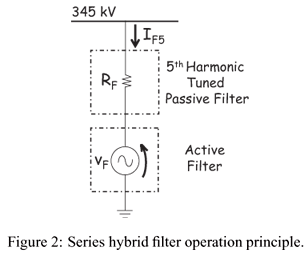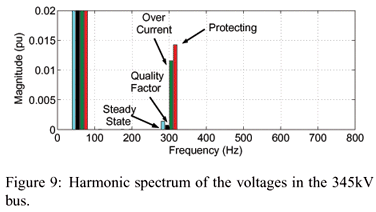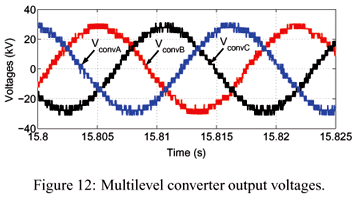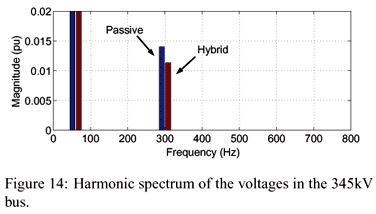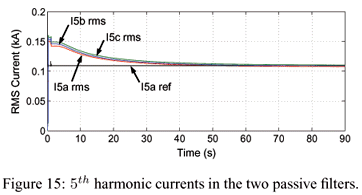Abstracts
Passive filters, commonly used to attenuate non-characteristic harmonics in High Voltage Direct Current (HVDC) systems, stay at risk of disconnection from the system due to overcurrent problems. A possible solution to solve the problems involving high harmonic levels would be the use of pure active filters. However, this alternative is unpractical due to the high power of the transmission systems. This paper proposes two different topologies of hybrid filters to damp harmonic resonance in power transmission systems. The first one combines a small-rated active filter in series with passive filters, limiting overcurrents, when existent, or improving its own quality factor. The second one consists of an active filter in parallel with passive filters, which compensates all eventual overcurrent in the system bus. Both topologies utilizes the state of the art in very high power semiconductors and multilevel power converters. Simulation results present a comparative analysis, highlighting the efficiency of, and the differences between, the two proposed hybrid filters.
Transmission systems; hybrid filters; cascaded multilevel power converters; power quality
Filtros passivos, comumente utilizados em sistemas de transmissão de corrente contínua em alta tensão (HVDC) para atenuar harmônicos não-característicos, estão sob constante risco de desconexão do sistema devido a problemas de sobrecorrentes. A utilização de filtros ativos puros seria uma das possíveis soluções para resolver o problema dos altos índices harmônicos. No entanto, essa alternativa pode ser impraticável considerando-se a alta potência dos sistemas de transmissão. Este trabalho propõe duas topologias distintas de filtros híbridos para o amortecimento harmônico em sistemas de transmissão de energia. O primeiro combina um filtro ativo de baixa potência em série com filtros passivos, limitando sobrecorrentes, quando existentes, ou melhorando o seu próprio fator de qualidade. O segundo consiste em um filtro ativo em paralelo com filtros passivos, compensando as eventuais sobrecorrentes no sistema onde está conectado. As duas topologias utilizam as mais novas tecnologias em dispositivos semicondutores para alta potência e conversores multiníveis. Resultados de simulações apresentam uma análise comparativa, destacando a eficiência e as diferenças entre os dois filtros híbridos propostos.
Sistemas de transmissão; filtros híbridos; conversores multiníveis; qualidade de energia
ELETRÔNICA DE POTÊNCIA
A comparative analysis of cascaded-multilevel hybrid filters applied in power transmission systems
Alexandre G. MerçonI; Lucas F. EncarnaçãoI; Luís F. C. MonteiroI; Emanuel L. van EmmerikII; Maurício AredesI
ILaboratório de Eletrônica de Potência e Média Tensão, Programa de Engenharia Elétrica COPPE/Universidade Federal do Rio de Janeiro, Centro de Tecnologia, Bloco I, Sala 156, Cidade Universitária, Caixa Postal 68504, CEP: 21945-970, Rio de Janeiro, R.J., Brasil; alexandre@coe.ufrj.br; lucas@coe.ufrj.br; lfcm@coe.ufrj.br; aredes@coe.ufrj.br
IILaboratory of Electrical Power Processing, Faculty of Electrical Engeneering, Delft University of Technology Mekelweg 4, 2628 CD Delft, The Netherlands; emmerik@coe.ufrj.br
ABSTRACT
Passive filters, commonly used to attenuate non-characteristic harmonics in High Voltage Direct Current (HVDC) systems, stay at risk of disconnection from the system due to overcurrent problems. A possible solution to solve the problems involving high harmonic levels would be the use of pure active filters. However, this alternative is unpractical due to the high power of the transmission systems. This paper proposes two different topologies of hybrid filters to damp harmonic resonance in power transmission systems. The first one combines a small-rated active filter in series with passive filters, limiting overcurrents, when existent, or improving its own quality factor. The second one consists of an active filter in parallel with passive filters, which compensates all eventual overcurrent in the system bus. Both topologies utilizes the state of the art in very high power semiconductors and multilevel power converters. Simulation results present a comparative analysis, highlighting the efficiency of, and the differences between, the two proposed hybrid filters.
Keywords: Transmission systems, hybrid filters, cascaded multilevel power converters, power quality.
RESUMO
Filtros passivos, comumente utilizados em sistemas de transmissão de corrente contínua em alta tensão (HVDC) para atenuar harmônicos não-característicos, estão sob constante risco de desconexão do sistema devido a problemas de sobrecorrentes. A utilização de filtros ativos puros seria uma das possíveis soluções para resolver o problema dos altos índices harmônicos. No entanto, essa alternativa pode ser impraticável considerando-se a alta potência dos sistemas de transmissão. Este trabalho propõe duas topologias distintas de filtros híbridos para o amortecimento harmônico em sistemas de transmissão de energia. O primeiro combina um filtro ativo de baixa potência em série com filtros passivos, limitando sobrecorrentes, quando existentes, ou melhorando o seu próprio fator de qualidade. O segundo consiste em um filtro ativo em paralelo com filtros passivos, compensando as eventuais sobrecorrentes no sistema onde está conectado. As duas topologias utilizam as mais novas tecnologias em dispositivos semicondutores para alta potência e conversores multiníveis. Resultados de simulações apresentam uma análise comparativa, destacando a eficiência e as diferenças entre os dois filtros híbridos propostos.
Palavras-chave: Sistemas de transmissão, filtros híbridos, conversores multiníveis, qualidade de energia.
1 INTRODUCTION
The harmonic propagation in industrial power systems has become a problem that affects seriously the power quality in distribution feeders due to the wide use of non-linear loads such as rectifiers, inverters and cycloconverters (Watanabe and Aredes, 2002). This problem is even more amplified because of the use of shunt capacitors installed on distribution systems for power factor correction. Normally, these capacitive filters are designed considering only the fundamental frequency of the system, 50 or 60 Hz. The harmonic propagation generated by power electronic equipments may cause harmonic resonance between the line inductances and those shunt capacitors. Researches on harmonic damping in distribution systems are in advanced stage and the use of active filters have presented good results (P. Jintakosonwit, 2003).
Recently, problems related to harmonic propagation have also been noticed in transmission systems, affecting the electric system in a severe way. Important parts of the Brazilian transmission system, like the area connected to the High Voltage Direct Current (HVDC) system, have been presenting this kind of problems (Plaisant and Reeve, 1999).
Passive filters at the Ibiúna substation, one of the converter stations of the Brazilian HVDC system, were designed to attenuate the harmonics generated by the converters as well as the non-characteristic harmonics generated by asymmetries in the converter transformers and the firing control. Since 1988, situations with high indices of harmonic distortion, mainly the 5th order harmonic, have been detected. Due to these high indices it was necessary to operate with two double-tuned passive filters for the 3rd and 5th harmonics. This is in disagreement with the original project, which was designed to operate with only one filter at this tuning, letting the other one as a backup filter.
At the Ibiúna substation, a pure active filter to solve the problem of the high 5th order harmonic voltage in the passive filters would not be economically and technically viable because of the high power involved. A hybrid filter, consisting of an active filter combined with the existent passive filters, would be a less expensive solution, uniting the advantages of both filters.
This paper proposes two hybrid filter topologies to work in high power systems such as HVDC systems. The first topology consists of an active filter in series with passive filters and the second one consists of an active filter in parallel with the passive filters. In both topologies the hybrid filter is in shunt with the system and multilevel converters are used to improve the filters capacity (J. Rodrigues, 2002).
2 THE IBIÚNA SUBSTATION
The Ibiúna substation is a part of the South - Southeast - Central West Brazilian transmission system and can be considered a complex system with a wide variety of power-system equipments, such as HVDC converters, passive filter banks, synchronous compensators and transmission lines with different AC levels coming from various parts of the power system.
With the purpose of testing the proposed hybrid filters, a simplified transmission system was modeled and simulated at PSCAD/EMTDCTM version 3.0.8. The digital module consists on a three-phase bus bar where a bank of passive filters and the active filters are connected. The bus bar is fed by a three-phase 345 kV voltage source and also connected in a three-phase unbalanced current source, which is used to represent the 5th harmonic pollution in the system. In the future a complex system model with more than 2200 electrical nodes is going to be used, allowing simulation results closer to real situations.
3 SERIES HYBRID FILTER
3.1 Power Circuit
In the first topology (Figure 1), the hybrid filter is composed of a multilevel cascaded active filter in series with the existent passive filters (F.Z. Peng, 1997). The active filter consists on two cascaded modules per phase, where each module is a single-phase voltage-source full-bridge inverter using four Integrated Gate-Commutated Thyristor (IGCT's) and one capacitor (K. Satoh, 2001).
Phase Shift Carriers Pulse Width Modulation (PWM) techniques are used, resulting in a switching frequency of 3 kHz in each phase (Y. Liang, 2000). The inverter uses the 5th harmonic tuned passive filters as output filters to reduce the high frequency harmonic components.
3.2 Operation Principle
Even for the tuned frequencies, 5th harmonic for example, the passive filters present non-zero impedance (Rf). Based on this principle the active filter works in two distinct situations, when the nominal current in the passive filters is not achieved, the active filter behaves like a negative resistance, generating a proportional voltage in counter-phase with the detected 5th harmonic current. This cancels the resistance of the passive filters and improves its quality factor. When an overcurrent occurs, the active filter increases the resistance of the passive filters, generating a proportional voltage in phase with the detected 5th harmonic current, protecting it from an excessive current value. This control is shown in Figure 2.
3.3 Control Circuit
The control-circuit consists of two distinct parts. The first one controls the DC-link voltage in each module (Figure 3.a), and the second one regulates the 5th harmonic current in each phase of the passive filters (Figure 3.b).
As presented in Figure 3.a, the control circuit compares a reference signal, Vcc(ref), with the capacitor voltage in each module, Vcc(a1), for phase A (k = a) of the module 1 (m = 1). The error passes through a low pass filter in order to reduce the signal noise. A Gain, Gcap(a), is adjusted over the filtered error signal by a Proportional Integrator (PI) controller. The output of the PI controller is multiplied by an unitary sinusoidal signal, Ia(PLL), which is synchronized by a Phase-Locked-Loop (PLL) circuit (H. Fujita, 2002). Therefore, the output generates a fundamental voltage reference, Va1(ref), responsible to control the DC-voltage for its respective module.
Figure 3.b shows the control circuit for each phase of the 5th harmonic current in the passive filters. Instantaneous aggregate-value concepts are applied to the 5th harmonic detected current, I5a, for phase A (k = a), which is extracted from the detection circuit. This signal is compared with a 5th harmonic reference current, I5a(passive), and then integrated to generate the 5th harmonic current control gain, G5a. This gain is multiplied by the 5th harmonic current, generating the 5th harmonic reference voltage, V5a(ref), which is responsible to control the 5th harmonic current in phase A of the passive filters.
The sum of the reference voltages, Va1(ref) and V5a(ref), results in a reference voltage that is used in an phase shift PWM inverter to generate the compensation voltage for phase A of the module 1. The other references are generated by a similar process. The differences between them are only the currents and capacitor voltages measurements. The reference signal, I5a(ref), is a calculated value based on the maximum capacity of the 5th harmonic current in the passive filters.
4 SHUNT HYBRID FILTER
4.1 Power Circuit
In the second proposed topology the hybrid filter is constituted by a shunt connection involving an active filter and the existent passive filters. The active filter consists of a three-phase cascaded multilevel voltage-source converter, where each phase-leg circuit is composed by 10 power modules connected in series. This structure allows 21 voltage levels on its AC side. Each power module is a single-phase full-bridge inverter with one capacitor at its DC-link and four IGCT's, switched through a phase-shift carries PWM. The IGCT's are switched at 800 Hz, which results in an equivalent switching frequency of 8 kHz due to the multilevel structure. The bank of high-pass passive filters at the Ibiúna's bus bar attenuate the high switching harmonics generated by the active filter.
The connection in the system is made through a three-phase transformer with turns ratio 10:1. Figure 4 presents the hybrid filter shunt topology connected in the Ibiúna's 345 kV bus. Each power module uses one capacitor of 10mF, regulated with 3 kV at the DC-link.
4.2 Operation Principle
If the nominal current in the passive filters is not achieved the active filter remains in stand by mode, ready to operate. When an overcurrent is detected in the passive filters, the active filter generates a 5th harmonic proportional current in order to eliminate the overcurrent only. In this case, the passive filters work on its nominal capacity. The overcurrent operation is shown in Figure 5.
4.3 Control Circuit
The control-circuit of the shunt hybrid-filter (Figure 6) is divided in two parts, one dedicated to the DC-link voltages and the other one to the 5th harmonic compensation current. In the DC-link voltages control-circuit, a signal generated by a PLL, Ia(PLL), is multiplied by the gain Gcap(a)'. This gain is obtained through the addition of the gain G1, calculated the same way as presented in Figure 3.a, and the gain G2, which considers the mean voltage of all DC-link capacitors in each phase-leg circuit.
To generate the 5th harmonic reference current, I5a(ref)', the detected current, I5a', is multiplied by a gain, G5a', which is generated by a circuit similar to the one presented in Figure 3.b. The fundamental reference current, Ia(ref)', and the 5th harmonic reference current, I5a(ref)', are used in the phase-shift carries PWM converter to synthesize the compensation current.
5 SIMULATION RESULTS
5.1 Series Hybrid Filter
The simulation results of the series hybrid filter are presented from Figure 7 to Figure 11. The system was simulated during 25 seconds. In order to represent the variation of the harmonic pollution in the 345 kV bus, three single-phase 5th harmonic current sources are inserted in the system, in each phase. In 0.1 seconds the harmonic pollutants sources are turned on, injecting 20 A rms each, not achieving the nominal current of the passive filters (55 A rms in each of the two filters). In order to simulate the overcurrent situation, at 5.1 seconds the 5th harmonic pollutant sources inject extra currents in the system, 143, 147 and 153 A rms, in phases A, B and C respectively.
The switching control circuit starts to operate after 1 second of simulation. In 1.05 second the active filter is connected in the system through a breaker. The capacitor voltage and the 5th harmonic control circuits start up in 1.1 and 1.2 second respectively.
Figure 7 shows the voltages generated by the multilevel converter. The switching frequency in each module is 1.5 kHz, resulting in a equivalent switching frequency of 3 kHz per phase in the output of the two modules in series.
The regulated voltages of the six DC-link capacitors in one active filter are presented in Figure 8. After 1.1 seconds, the capacitor voltages are charged following the reference value. When the overcurrent is injected in the system, after 5.1 seconds, a variation in the capacitor voltages can be noted. However, the maximum variation in the capacitor voltage is less then 10% of the reference voltage, providing an adequate power so that the 5th harmonic can be generated. Capacitors of 1mF are used in the DC-link of each power module.
Figure 9 shows the harmonic spectrum of the phase voltage in the 345 kV bus. When the active filter improves the quality factor of the passive filters, the 5th harmonic voltage at the bus decreases (from 0.142% to 0.072%). When the active filter protects the passive filters from an overcurrent, the 5th harmonic voltage increases as expected, achieving 1.43%. This value is in accordance with ONS (Operador Nacional do Sistema Elétrico), which is standardized at 2% for the 5th harmonic. During an over current situation, without the active filter, the passive filters would have to be disconnected, resulting in a harmonic distortion beyond the 2% standard.
Figure 10 shows the 5th harmonic rms current in the passive filters. Until 5.1 seconds, when the filters nominal current is not achieved, the active filter cancels the resistance of the passive filters, increasing the 5th harmonic rms current. After 5.1 seconds, when an overcurrent is detected, the active filter increases the resistance of the passive filters, protecting them against an overcurrent situation. A 10 seconds lag, caused by a delay in the detection circuit can be observed in the response of the series active filter. This lag does not compromise the operation of the passive filters, since the integration time of its protection is 20 minutes.
In order to analyze the instantaneous performance of the series hybrid filter, Figure 11 presents a 50 ms interval with the voltage at the 345 kV bus (in kV), the output voltage generated by the active part of the series hybrid filter (in kV multiplied by 100) and the current at the hybrid filter (in kA multiplied by 1000) for phase A. At this interval the active filter generates a fundamental voltage in counter-phase with the fundamental current and a 5th harmonic voltage in phase with the 5th harmonic current at the passive filters, in order to discharge the capacitors and protect the passive filters respectively.
5.2 Shunt Hybrid Filter
The simulation results of the shunt hybrid filter are presented from Figure 12 to Figure 16. The system was simulated during 90 seconds. The same way as in the series hybrid filter, a 5th harmonic current source is inserted in each one of the three phases to represent the harmonic pollution in the system. Similarly, in 0.1 seconds the three pollutant sources are turned on, injecting 20 A rms each. As the overcurrent situation was not achieved in the passive filters, in 0.3 seconds the three pollutant sources goes from 20 A to 199, 212 and 204 A rms, in phases A, B and C, respectively, been divided equally over the two identical passive filters.
One second after the beginning of the simulation, a breaker is switched to connect the active filter in the system. At this time, the IGCTs are kept opened so that the capacitors in each phase are pre-charged through the diodes. The pre-charge occurs almost instantaneously but it is not enough to charge the capacitors with the reference voltage (3 kV). In 1.1 seconds the DC-link voltage control circuit, the 5th harmonic control circuit and the switching control circuit begin to operate, unblocking the IGCTs. Figure 12 shows the 21 voltage levels, for phases A, B and C, generated by the cascaded-multilevel PWM converter.
The regulated voltages over the 10 capacitors, for phase A of the active filter, are presented in Figure 13. As it can be seen, variations in the voltages occur when the pollutant overcurrent enters in the system. In spite of those variations, the control circuit is able to keep the capacitor voltages within a range of ± 10% of the reference voltage, not affecting the 5th harmonic compensation.
In Figure 14 the harmonic spectrum of the phase voltage in the 345 kV bus can be noticed before and after the actuation of the shunt active filter. As it can be observed, the 5th harmonic distortion is reduced and the harmonic content is kept below the 2% limit established by the ONS. In Figure 15 the passive filters overcurrent protection is shown through the decrease of the 5th harmonic rms current when the control circuit starts to operate.
The instantaneous values of the voltage at the 345 kV bus (in kV) and the currents in the active and passive parts, for phase A, of the shunt hybrid filters are presented in Figure 16. As it was expected, the current in the passive filters (in kA multiplied by 500) is in phase with the current in the active filter (in kA multiplied by 500).
6 CONCLUSIONS
Besides limiting the passive filter currents, the series hybrid filter also improves the quality factor of the filter when the nominal current is not achieved. Other important advantages of this topology are its small rated power circuit and the absence of matching transformers.
The results with the shunt hybrid filter presented its good performance to compensate the overcurrent in the passive filters and its effectiveness to improve the THD of the 345 kV bus where the active filter is installed. A matching transformer is necessary in this case.
The authors continues to develop researches focused on multilevel structures for high power systems. In the future, it is intended to simulate the proposed hybrid filters in the complete digital model of the Ibiúna system.
Artigo submetido em 10/06/2006
1a. Revisão em 16/01/07
Aceito sob recomendação do Editor Associado Prof. Enes Gonçalves Marra
- F. Z. Peng, J. W. Mckeever, D. J. A. (1997). Cascade multilevel inverters for utility applications, Proc. of the IEEE International Conference on Industrial Electronics, Control, and Instrumentation, Vol. 2, New Orleans, pp. 437 442.
- H. Fujita, T. Yamasaki, H. A. (2002). A hybrid active filter for damping of harmonic resonance in industrial power systems, IEEE Transactions on Power Electronics 15(2): 215 222.
- J. Rodrígues, J. S. Lai, F. Z. P. (2002).Multilevel inverters: A survay of topologies, controls, and applications, IEEE Transactions on Industrial Eletronics 49(4): 724 738.
- K. Satoh, M. Y. (2001). The present state of the art in highpower semiconductor devices, Proceedings of the IEEE 89(3): 813 821.
- P. Jintakosonwit, H. Fujita, H. A. S. O. (2003). Analysis and design of an active power filter to cancel harmonic currents in low voltage electric power distribution distribution systems, IEEE Transactions on Industry Applications 39(2): 556 564.
- Plaisant, A. and Reeve, J. (1999). An active filter for ac harmonics from hvdc converters - basic concepts and design principles, Proc. of The IEEE Power Engineering Society Summer Meeting, Vol. 1, Alberta, pp. 395 400.
- Watanabe, E. H. and Aredes, M. (2002). Power considerations on shunt/series current and voltage conditioners, Proc. of the 10th International Conference on Harmonic and Quality of Power, Vol. 2, Rio de Janeiro, pp. 595 600.
- Y. Liang, C. O. N. (2000). A power-line conditioner based on flying-capacitor multilevel voltage-source converter with phase-shift spwm, IEEE Transactions on Industry Applications 36(4): 965 971.
Publication Dates
-
Publication in this collection
24 Apr 2008 -
Date of issue
Mar 2008
History
-
Received
10 June 2006




